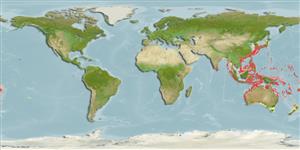Environment: milieu / climate zone / depth range / distribution range
Ekologi
laut dasar (demersal); kisaran kedalaman 85 - 154 m (Ref. 9824). Temperate
Indo-West Pacific: southern Japan to the South China Sea. Also recorded from northwestern Australia (Ref. 5978) and New Caledonia (Ref. 9824).
Size / Weight / umur
Maturity: Lm ? range ? - ? cm
Max length : 17.0 cm TL jantan/; (Ref. 9824)
Duri punggung (Keseluruhan (total)) : 0; duri punggung lunak (Keseluruhan (total)) : 99 - 106; Duri dubur: 0; Sirip dubur lunak: 76 - 83. Snout sharp. Maxillary extending to below or beyond middle of lower eye. No gill rakers on upper limb. Cycloid scales on ocular side. Caudal fin having 3 simple upper and lower rays. No dark blotch on pectoral and pelvic fins. Second dorsal fin ray elongated in male.
Inhabits bottoms with broken coral, shell, pebbles, and gray mud. Feeds on bottom-living animals.
Life cycle and mating behavior
Kematangan | Reproduksi, perkembang biakan | Pemijahan | telur-telur | Fecundity | Larva
Masuda, H., K. Amaoka, C. Araga, T. Uyeno and T. Yoshino, 1984. The fishes of the Japanese Archipelago. Vol. 1. Tokai University Press, Tokyo, Japan. 437 p. (text). (Ref. 559)
Status IUCN Red List (Ref. 130435: Version 2024-1)
ancaman kepada manusia
Harmless
penggunaan manusia
Perikanan: tidak ada kepentingan
Alat, peralatan
laporan khas
muat turun XML
Sumber internet
Estimates based on models
Preferred temperature (Ref.
123201): 15.3 - 26.8, mean 21.2 °C (based on 167 cells).
Phylogenetic diversity index (Ref.
82804): PD
50 = 0.5000 [Uniqueness, from 0.5 = low to 2.0 = high].
Bayesian length-weight: a=0.00741 (0.00394 - 0.01394), b=3.02 (2.86 - 3.18), in cm total length, based on LWR estimates for this species & (Sub)family-body (Ref.
93245).
Trophic level (Ref.
69278): 3.5 ±0.37 se; based on food items.
Daya lenting (Ref.
120179): sedang, Waktu penggandaan populasi minimum 1.4 - 4.4 tahun (Preliminary K or Fecundity.).
Fishing Vulnerability (Ref.
59153): Low vulnerability (10 of 100).
